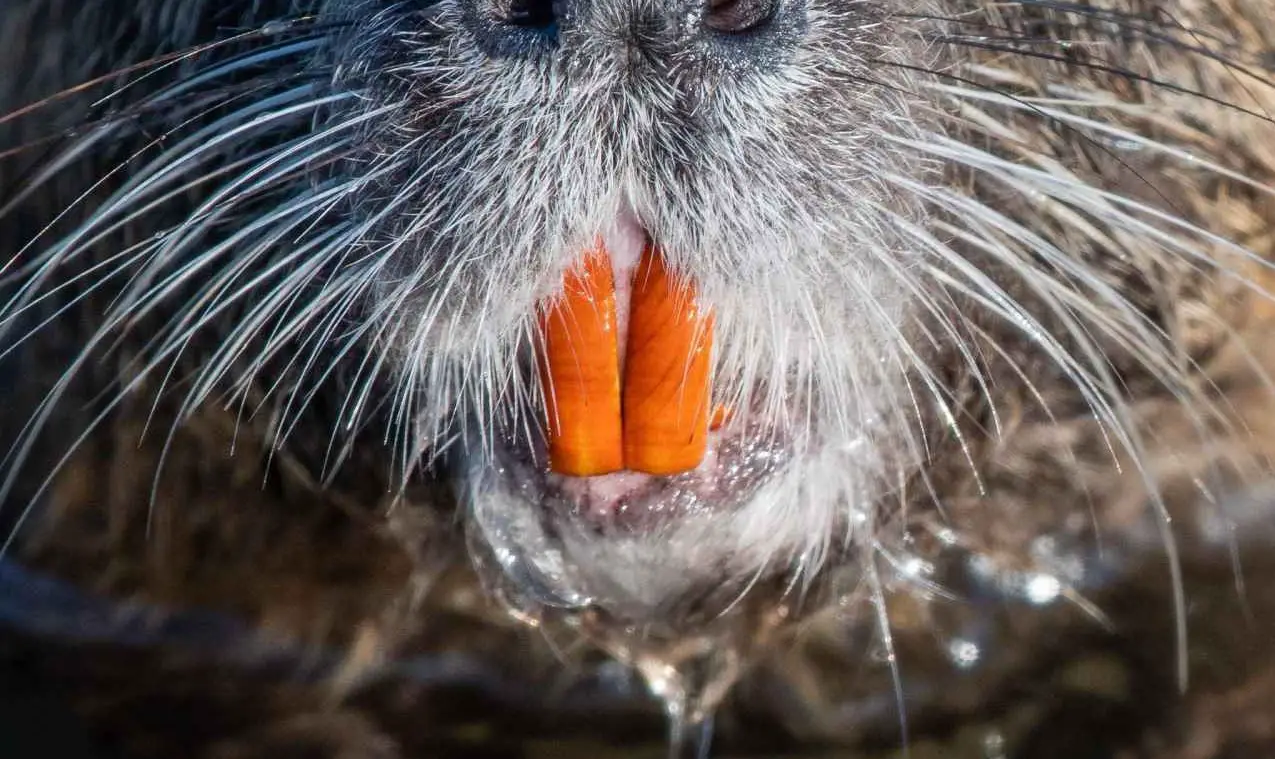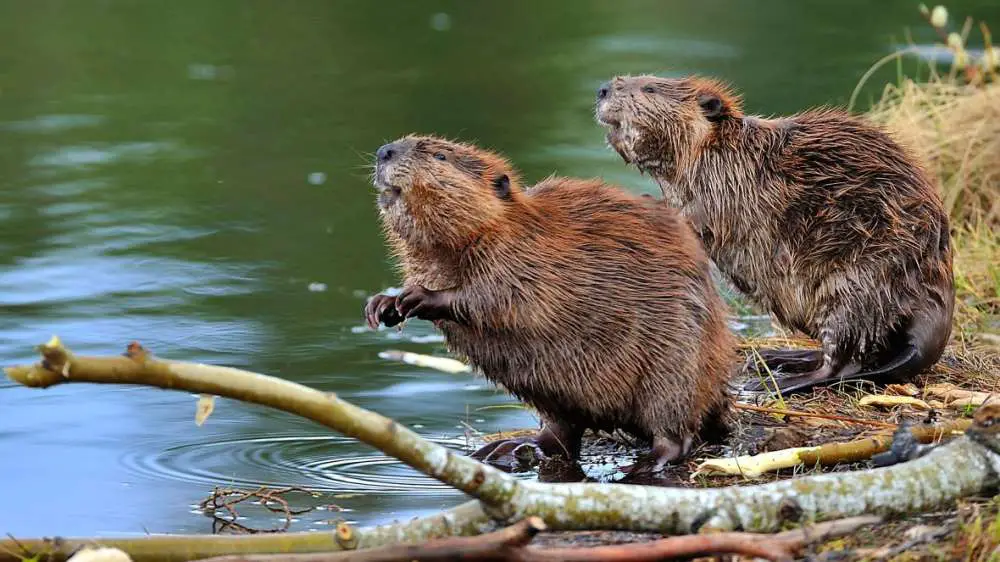Why Do Beavers Have Orange Teeth? Are they Metallic Teeth?

Beavers, those industrious architects of the animal kingdom, are famed for their ability to create intricate dams and modify their habitat. Yet, one curious aspect of these creatures often goes unnoticed: their bright orange teeth.
In this article, we will dive into the world of beavers to unravel the mystery behind their strikingly hued dental equipment. Are beavers sporting metallic teeth, or is there more to the story?

The Remarkable Beavers
Before we delve into their unique dental features, let’s get acquainted with these exceptional rodents. Beavers are among the largest species of rodents in the northern hemisphere, known for their incredible habitat-altering abilities.
They construct dams using mud, sticks, rocks, and branches, creating not only a watery haven for themselves but also a thriving aquatic ecosystem for countless other creatures.
Beavers are known for their strong, stocky bodies and distinctive paddle-like tails. They are excellent swimmers, capable of navigating swiftly through water with the help of their webbed hind feet.
Additionally, beavers possess remarkable adaptations for both aquatic and terrestrial life, making them truly versatile creatures in their natural habitats.
The Mystery of Orange Teeth
The most distinctive feature of beavers’ teeth is their vibrant orange color. But why are their teeth orange?
The secret lies in the composition of their dental structure. Beavers have exceptionally strong, long, and sharp incisor teeth that are crucial for their wood-chewing activities.
These incisor teeth are highly specialized for gnawing through tree bark, branches, and other woody vegetation that makes up a significant portion of their diet.
Unlike humans, beavers’ teeth continue to grow throughout their lives. This constant growth is necessary because the abrasive nature of woody materials can wear down their teeth quickly.
The Iron-Clad Enamel
The orange hue of beavers’ teeth is attributed to the presence of iron-rich outer enamel. This iron-rich enamel not only gives their teeth their unique color but also imparts incredible strength, enabling them to cut and break down branches with ease.
This unique enamel composition serves as a natural armor for beavers’ teeth. It not only makes their teeth more resilient but also helps in preventing decay and damage despite the constant wear and tear they experience while chewing through wood.
The Mighty Incisors
Beavers’ incisor teeth serve as formidable tools in their constant quest for wood. These front teeth act like precision blades, allowing them to slice through tough branches effortlessly.
Their teeth grow continuously throughout their lives, but the daily wear and tear from chewing wood help keep them in check.
Beavers are known to be meticulous when it comes to maintaining their teeth. They spend a considerable amount of time gnawing on various materials, which not only helps control the length of their teeth but also keeps them sharp and in optimal condition for their important tasks.

Engineering Marvels: Beaver Dams
Beavers’ teeth are not the only remarkable aspect of their biology. They are also celebrated for their engineering prowess.
These industrious rodents construct dams and lodges that transform their surroundings, providing a stable aquatic habitat for various creatures.
Beaver dams are constructed with a combination of materials, including sticks, logs, and mud. These structures serve multiple purposes.
They create deep pools of water, which help protect beavers from predators and provide a reliable source of food during the winter months when the water surface freezes.
Additionally, the dams alter the landscape, influencing the flow of water and promoting the growth of aquatic plants.
The Aquatic Adaptation
Beavers are not only adept on land but also underwater. They can stay submerged for up to 15 minutes, thanks to their large webbed feet, which function like swimming fins.
Their waterproof fur and specialized eyelids that act like goggles further enhance their aquatic capabilities.
These adaptations make beavers exceptional foragers. They can access underwater vegetation and transport branches and logs with ease.
This aquatic lifestyle also plays a crucial role in their survival, as it provides them with a unique food source and additional protection from predators.
Amazing Beaver Facts
Now, let’s delve into more fascinating facts about beavers:
1. Construction Experts
Beavers are renowned for their dam-building skills, and these structures are not just haphazard heaps of sticks and mud. Beaver dams can be quite elaborate, with some reaching lengths of over 2,000 feet (610 meters). Some beaver dams are even visible from space!
2. Pioneers of Sustainability
Beaver dams play a vital role in maintaining healthy ecosystems. They improve water quality, provide habitat for numerous species, and help control flooding by slowing the flow of water downstream.
3. Diverse Diet
While beavers are known for their wood-chewing abilities, they are not strict vegetarians. They also consume aquatic plants, leaves, and roots, making their diet more varied than commonly believed.
4. Family-Centric
Beavers are highly family-oriented animals. They live in family groups known as colonies, which typically consist of the parents and their offspring. The family works together to maintain their lodge and dams.
5. Night Shift
Beavers are primarily nocturnal creatures, meaning they are most active at night. This behavior helps them avoid predators and perform their construction and foraging activities with reduced risk.
6. Fur Trade Impact
Beavers played a significant role in the fur trade in North America during the 18th and 19th centuries. The demand for beaver pelts, used to make felt hats, led to extensive trapping and population declines.
7. Environmental Engineers
Beavers’ dam-building activities can dramatically alter the landscape. In some cases, they have even created wetlands that support a wide range of plant and animal species.
8. Vocal Communicators
Beavers use a variety of vocalizations to communicate with each other. These sounds include warning signals, greetings, and distress calls, allowing them to coordinate their activities within the colony.
The Role of Beaver Teeth in Survival
Beavers’ orange teeth play a vital role in their survival. They rely on these powerful incisors not only for acquiring food but also for creating shelter and defending themselves against predators.
Their teeth are truly multi-purpose tools that enable them to thrive in their unique environment.
Beaver Teeth and Human Fascination
The peculiar orange color of beavers’ teeth has captivated human curiosity for centuries. Early European settlers in North America marveled at these distinctive teeth, often mistakenly believing them to be made of metal.
Today, researchers continue to study beaver teeth, seeking insights into their remarkable strength and durability.
Beaver teeth have even found a place in popular culture, symbolizing industriousness, resourcefulness, and adaptability.
They serve as a reminder of the incredible diversity and ingenuity found in the animal kingdom.
Conclusion
Beavers are true marvels of nature, with their orange teeth being just one facet of their remarkable adaptations. These rodents have mastered the art of modifying their environment, making them essential players in the ecosystems they inhabit. While their teeth may not be metallic, they are undeniably strong and pivotal to their survival.
FAQs
Are beavers’ teeth actually made of metal?
No, beavers’ teeth are not made of metal. Their teeth are orange due to the iron-rich outer enamel, which gives them strength and durability for their wood-chewing activities.
How fast can beavers chew down a tree?
Beavers have an impressive chewing rate and can bring down a 10-foot tree in less than 10 minutes, thanks to their sharp incisor teeth.
What is the purpose of beavers’ dams?
Beavers create dams primarily to retain water and create a suitable living habitat for themselves. However, these dams also benefit other aquatic creatures by providing a thriving ecosystem.
How do beavers stay underwater for so long?
Beavers have special adaptations, such as webbed feet and waterproof fur, that enable them to stay submerged for up to 15 minutes. Their eyelids act like goggles, allowing them to see underwater.
Why are beavers considered habitat engineers?
Beavers modify their environment by constructing dams and lodges. This engineering skill transforms their surroundings, creating stable aquatic habitats for various wildlife.
